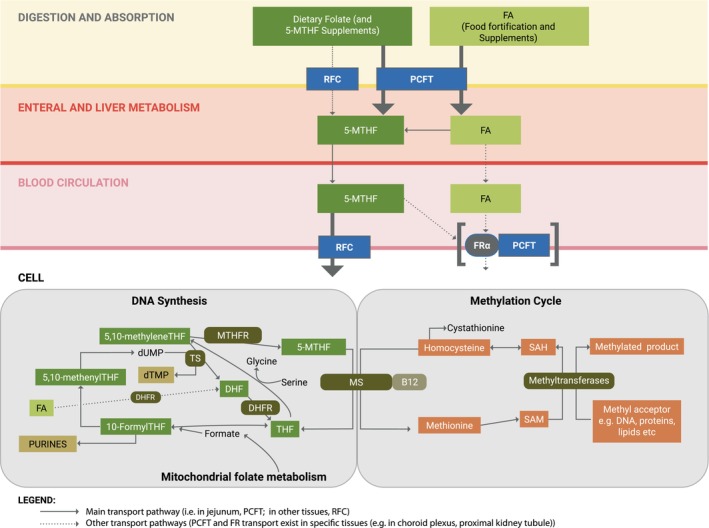FIGURE 4.

Overview of folate metabolism and transport. Folate metabolism is depicted, from its intestinal absorption to its intracellular function as a carrier of one‐carbon units (methyl, methylene, methenyl and formyl moieties) in the de‐novo synthesis of purines and thymidine and the transfer of methyl groups to methionine for use in methylation reactions. Dietary folates are converted from polyglutamate forms to monoglutamates in the duodenum and are absorbed in the intestine primarily via the PCFT, but also to some extent through the RFC, depending on local pH. Folates enter the enteral and hepatic system mainly as 5‐MTHF, and excess folates emerge into the blood circulation in this form. 5‐MTHF enters cells via the RFC and becomes incorporated in the cellular folate pool after passing through the cobalamin dependent enzyme, methionine synthase (MS), where the methyl group is removed and attached to homocysteine, producing methionine. THF, the other product of the MS reaction, is polyglutamated and picks up one‐carbon units as formyl groups from mitochondrial derived formate or as methylene groups from serine. 10‐Formyl groups are passed to intermediates in the de‐novo purine synthesis pathway, and 5,10‐methylene groups are used to produce thymidylate from dUMP. In specific tissues (e.g. choroid plexus, proximus kidney tubule), a family of receptors, named folate receptors (FRs), can transport 5‐MTHF or folic acid across cellular barriers by endocytosis, probably linked to the PCFT transporter. DHF, dihydrofolate; DHFR, dihydrofolate reductase; dUMP, deoxyuridine monophosphate; dTMP, deoxythymidine monophosphate; FA, folic acid; FR, folate receptor; MS, methionine synthase; MTHFR, 5,10‐methylenetetrahydrofolate reductase; PCFT, proton‐coupled folate transporter; RFC, reduced folate carrier; THF, tetrahydrofolate; TS, thymidylate synthetase; SAH, S‐adenosyl homocysteine; SAM, S‐adenosyl methionine.
